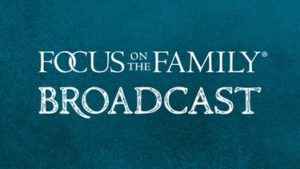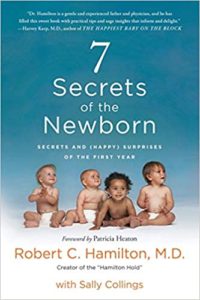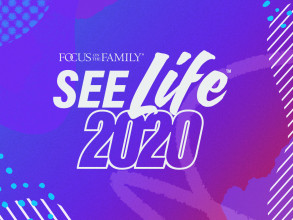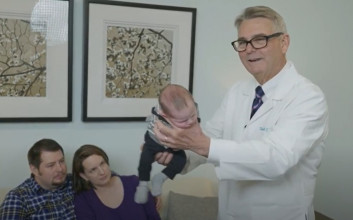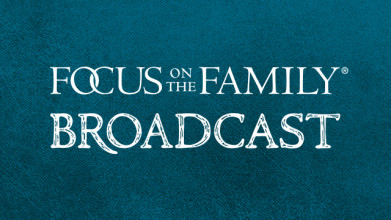Excerpt:
Dr Robert Hamilton: He – he looked at my son, Josh, and there was that moment where he truly – it was a moment of delight. And it was – he smiled – and there was a – this shine in his eyes, this brightness that I had not seen for a long time. Um, truly, a powerful moment for him. It was a moment that you kind of go, why was Josh born at this time? And I kind of go, maybe – maybe for this moment.
End of Excerpt
John Fuller: That’s Dr. Robert Hamilton talking about how the birth of his first son brought tremendous hope to a tragic family situation. This is Focus on the Family. Your host is Focus president, Jim Daly and I’m John Fuller.
Jim Daly: John, babies are such an amazing example of God’s handiwork. And obviously, babies and kids have a special place in God’s heart. We saw that when Jesus got upset at the disciples for not letting the children come to Him. And not only does God say in His Word that we should be more like children in our relationship with Him, He says He knows us from the very beginning of our lives. From the very moment we’re conceived. That’s pretty incredible. And that’s why we’re so passionate about the pro-life movement here at Focus on the Family. And why we’re celebrating pre-born babies through our See Life 2020 event that’s coming next month.
John: That’s September 26th and you can find out more about the free, online See Life 2020 event at focusonthefamily.com/broadcast.
Jim: And today, John, I’m looking forward to sharing the rest of our conversation with Dr. Robert Hamilton, as he moves into the more scientific side of his profession. Digging into why he used to be pro-choice and the amazing details of a baby’s development.
John: If you missed anything from that first part of our conversation, be sure to stop by the website, check us out on the YouTube channel, pull us up on the app, or look for the podcast. As I mentioned last time, Dr. Hamilton has over 3 decades of experience as a pediatrician. Even more experience as a dad to six and grandfather of 9. And is the author of the book called 7 Secrets of the Newborn: Secrets and (Happy) Surprises of the First Year. We’ve got copies of that, of course, at our website. Dr. Bob is perhaps best known as the creator of the “Hamilton Hold” which is special way to calm a crying baby. And we’ve got a video of him demonstrating that hold at the website. Let’s go ahead and re-join the conversation now on today’s episode of Focus on the Family.
Jim: Uh, Dr. Bob, welcome back.
Robert: Thank you.
Jim: (Laughter).
Robert: …Uh, Jim and John. It’s a pleasure to be here.
Jim: You know, we’re going to demonstrate on the Focus website that Hamilton Hold. And, uh, you tell me that it’s good for really small babies. It’s not for teenagers.
(LAUGHTER)
Robert: Not – not…
Jim: The Hamilton Hold might be a little different for teenagers (laughter).
Robert: I’m working on that. I’m in the – I’m in the lab trying to figure out…
Jim: Yeah, right.
Robert: …How to do that.
Jim: It’s taken years to perfect.
Robert: And uh, you know, when I get that one, you know, I…
Jim: (Laughter).
Robert: …It’ll truly go viral.
Jim: I bet you might have 60 million take a look at that one.
Robert: Yeah, that’s my goal. Yes.
Jim: Hey, uh, you haven’t always been passionate for babies. In fact, I understand that you considered yourself kind of pro-choice. And I don’t know that it’s fair to equate the two. But, um, you were more pro-choice in med school. Why were you in that spot, and how did you come around to rethinking it?
Robert: Uh, Jim, that’s a great question, and it actually causes me to kind of reflect on that transition…
Jim: Sure.
Robert: …Because the reality is it was the culture that I was in. The culture of medical school, the culture of medicine, in general, today is that abortion is part of the landscape. Um, when Roe v. Wade happened in 1973, I was a young man. I had other things on my mind. I wasn’t – it wasn’t on my radar.
Jim: Right.
Robert: It wasn’t like I really thought through the issue that carefully. So, part of me falling into the, uh, quote, “pro-choice” camp, if you will, was really one of by default. It wasn’t like it was very intentional. It wasn’t really thought through. And that was, um, something that I ultimately ended up, you know, dealing with a little bit later on in my training.
Jim: Yeah. I would think in med school, particularly, that would have been kind of – everybody was moving that direction. Professors were probably very insistent or at least told people what their views were. And it probably fell 80% or more toward a pro-choice perspective. I don’t know. But…
Robert: Oh, no. It’s very high. And I think that, uh – listen. When I got into medical school, I was, uh – it was a decade later. And, uh, the fact is, is that, you know, that was kind of the way it was. I remember during my OB-GYN rotation, uh, as a third-year medical student we were kind of dividing up our responsibilities, and I was, uh, told that I was going to go to a TAB. And I didn’t know what a TAB was, but I learned that it was a therapeutic abortion. And so, the reality is that, first of all, the language that abortionists use is oftentimes shrouded in nuances that – they’re not always clear.
Jim: Soft language.
Robert: Yes. And so…
Jim: Yeah, I know. Like – yeah.
Robert: And so, if I think about a TAB, there was actually a, uh, soda at one point called Tab.
Jim: Right.
Robert: And I go, “Okay. TAB, yeah, okay, whatever.” I went to that. I went – I remember going as a third-year student, and I watched an abortion. I remember walking out of the room thinking, this – it didn’t feel right.
Jim: Huh.
Robert: It felt very heavy. It felt – I remember walking out very sad.
John: Hmm.
Robert: And, you know, here I am, uh, not really – not really thinking through. And I think a lot of people don’t really think through the issue. and so that was me. And – but I had to think that day because I saw one. And I’m thinking, “You know what? There was another life that entered that room and is no longer with us.”
Jim: Right.
Robert: And I remember looking at that woman, and, you know, she wasn’t happy. You know, she was going through a thing, a procedure, which, uh, was invasive to her, number one. And I’m only – I didn’t talk to her. No one did.
Jim: Right.
Robert: It was kind of like, don’t talk to her because we don’t want to know what she’s thinking. But I know that – I know, looking at her face, I could tell that this was not something she was proud of, not something she was happy about.
Jim: Yeah. Well, it’s so amazing – and this is a big battle in the culture, uh, when you look at it right now. I’m sure back in ’73, maybe politicians thought once it’s declared constitutional by the Supreme Court, argument over. But there’s something intrinsically wrong at the very core, and that’s why this continues, this contest of moral ideas. I think, at one level, abortion is illogical, um, you know, when you think about it. One of the things that I’m concerned about – I’d love to get your perspective as a pediatrician. For the abortion industry – and let’s just – you know, Planned Parenthood probably does a little more than about a third of the abortions in this country, uh, over 300,000 a year. And it’s amazing to me that they’ve been able to divide women from that natural, God-given desire to be that nurturing person. Speak to that. That, to me, is a profound and dark achievement.
Robert: Well, it is. And part of it is the fact that they – it is considered to be okay. It’s considered to be something that you kind of – sometimes they feel like they have to do. Women are conflicted. This is – I don’t – I know many people who have had – women who’ve had abortions. And they’ll tell you even before or after their change of heart, uh, they, uh, in terms of their faith they were conflicted way back when. And so, you’re right. I think that the groups – uh, Planned Parenthood, I mean, is number one. What they’ve been able to do is obfuscate the truth.
Jim: Right.
Robert: And they’ve been able to hide the truth. Uh, one of the ways that, you know, uh, you can shut down an abortionist or even, you know, these people is, you say, “What are you doing? Tell me what you do. Tell me the processes you go through when you have an abortion.” And when you actually – when they – they won’t articulate that. They’ll never come back to you and say…
Jim: They hide it.
Robert: They have to hide it, Jim.
Jim: Right.
Robert: They have to hide it, because if they actually said, “Here is what we do” and they go through the process – because it is a process. Okay? It is a procedure. When they do that, it’s terribly damning. It’s terribly damning. So, that’s what’s happened.
Jim: Yeah.
Robert: We’ve been able to hide the truth. I will tell you that, you know, now, in a lot of the pregnancy centers, resource centers…
Jim: Yeah, the PRCs.
Robert: They’re beginning to actually have ultrasounds in them. And they can show people, okay, this is what your baby looks like. You can – you can see it, and this is not a blob. It is not a tissue. It is a real human being, uniquely different than any other human being that has ever been on the face of the earth.
Jim: Yeah. It’s so exciting. We’ve been doing that Option Ultrasound program for 15 years now. And, you know, I just am so proud of these pregnancy resource clinics, that a lot of them work on a shoestring budget, a lot of volunteers, very, uh, loving and kind – mostly women who are out there trying to help women make the best choice they can make, which is to give your baby life, even if you have to give that baby up for adoption. And, uh, I am – I’m just so proud of them. And here’s a stat that’s so amazing. I remember meeting with a Planned Parenthood, uh, representative. And they said it’s, on average, about $600 to do an abortion. Here at Focus on the Family, you can save a baby’s life for $60 – that program. I mean, that’s what’s so amazing. And I hope people, uh, would get on board with us and help us. I would love to see another 600,000 babies saved by 2025. The – what we’re saying is a million alive by 2025. Wouldn’t that be awesome? And I just am excited about this. And so many people are realizing, especially young people, that abortion is not right – immoral, in fact. Sixty-one percent – get this, Dr. Bob. Sixty-one percent in a recent Marist poll said that – and these are abortion-minded people. Sixty-one percent said abortion after the first trimester is not right. These are abortion-minded people. Think of that. Now, we believe in life from conception. And so, we’re not going to differentiate between the second-, third-trimester pregnancy and a first trimester. But the point is, even they don’t agree with late-term abortion or second-term abortion. So, I’ve said a lot there. What do you want to respond to? (Laughter)
Robert: No. I think that when people know, when people think about it – and I think it’s innate in human beings. And I think that human beings, when they really look at the truth and they really understand what is happening, they will change their mind. By the way, my transformation, if you want to hear that, is that – what happened to me is I was in my training. I was doing my neonatal intensive care rotation. And, uh, we were doing all we could to save, you know, children who were 24, 25, 26, 27 weeks gestation. Clearly…
Jim: So, this is the NICU unit.
Robert: The NICU.
Jim: Yeah.
Robert: Yeah, I was in the NICU. And I spent hours and hours in NICU, you know, overnight and weekends and everything. And so, we on one into the hallway, were spending great resources, hundreds of thousands of dollars to preserve and save the life of a lovely child. On the other end of the hall, there were babies being aborted at the same gestational age. And so, that was the beginning of my transformation. And I – basically, what happened, John and Jim, is I got educated. I learned something. I actually said, “Okay, what is it all about?” And after a while, I said, “You know what? I have to proclaim who I am. I am not – I’m not pro-choice. I am pro-life.” And I did things. I actually – there was a movie called The Silent Scream, which was put out by a guy named Bernard Nathanson.
Jim: Yeah, one of the early pro-life films.
Robert: Very early. I met Dr. Nathanson, and I brought that film to UCLA. I showed it to the residents. And…
Jim: God bless you. That took some guts.
Robert: (Laughter).
Jim: Seriously.
Robert: I – you know, my grade point average went down at that point but, uh, because some of the professors showed up and they sat in the back, and they were glum, and they were angry. And they couldn’t respond because if you remember that film, which showed, actually, you know, an ultrasound of a child being aborted, um…
Jim: And Bernard Nathanson, just for those that don’t remember him, he was pro-abortion. He was the beginning of NARAL, the National Abortion Rights League. And he was one of the strategic thinkers, a pediatrician who, you know, helped pioneer abortion. And then he flipped.
Robert: He flipped. And I think that he – and, by the way, he incurred the absolute anger and furiousness of that whole…
Jim: Yeah.
Robert: …That whole culture. But yeah.
Jim: He was a traitor to them.
Robert: He was a traitor. And – but he was also, uh, a person who loved truth.
Jim: Yeah.
Robert: And he was an interesting guy. And you know what? That film changed a lot of lives. It definitely changed my thinking about it. And when I showed it to the medical students, they were kind of going, “Wow.” And, uh…
Jim: (Laughter).
Robert: And so, anyway, yes, it did – it definitely, you know, represented a, uh, total change in my feeling about this issue.
Jim: Let’s move to the miracle of a baby’s development, uh, ’cause, again, I just – it puts a smile on my face – the Lord knitting this child together in the mother’s womb. Talk to us about how miraculous each life is. You say there are millions of things going on, literally, uh, during every moment of pregnancy. Describe what’s happening for that baby.
Robert: Sure. Uh, and that – it’s a joy for me to do that. Well, first of all, the – one of the beginning is the conception. Conception is a moment where that joining together of the egg and the sperm is that moment of time in time where a new individual is actually being – the template is there. Now, I will tell you that if you – this is something I mentioned in my book, is that that moment, it actually has a little bit of fireworks with it. It…
Jim: (Laughter) Yes, it does.
Robert: It does. And in fact, there is actually a burst of light that happens.
Jim: Is it right?
Robert: True. And people who do in vitro fertilization have been saying this. And what – there is a thing called a zinc burst. And so, when the conception happens, there’s actually a, uh, burst of light – literally true light that happens…
Jim: Wow.
Robert: …As a result of this egress – uh, there’s an ingress of calcium ions, and there’s an egress of zinc ions that kind of come out of the…
Jim: And produces this light.
Robert: There’s actually a little bit of a flash of light.
Jim: That’s amazing, given the Scripture, “I’m the light of the world.”
John: That’s beautiful, yeah.
Jim: And we’re made in His image. Wow.
Robert: It is a beautiful thing. And, uh, I tell people that this is like, you know, in heaven, there is this glory. And actually, this event, this spark of light, has been going on in the fallopian tubes of women for forever. I actually spoke with the researcher. This is actually relatively new information. And I spoke with the researcher who actually discovered this, and, um, I said, “What did it feel like when you actually saw this burst?” And she said, “I literally got goosebumps.” I – she – and I said, “What a wonderful way to herald a new life” – with this little boom, little burst of life.
Jim: I love that.
Robert: Yeah.
Jim: What happens after that?
Robert: Well, after that, I mean, this, uh – this conceptus begins to kind of divide very quickly. These daughter cells happen. It kind of tumbles down, uh, the fallopian tube. Eventually, that morula, we call it, attaches itself to the wall of the uterus. And then division – you know, you form the placenta. You form this – you know, all these things are going on. And amazingly, so quickly, you know, you’re talking about a heart beating in weeks…
Jim: Right.
Robert: Okay? A heart is formed, lungs are being formed, rudimentary within the first – really the first trimester of that child’s life.
Jim: Right. I mean, five, six weeks, right?
Robert: Everything’s there.
Jim: Right.
Robert: The – the primordial brain. Everything’s already there. It’s truly an amazing thing. And then after, you know – really the later stages of development are just simply growing. Uh, the child is getting bigger, and bigger, bigger. Neurons, of course, are multiplying. They, uh – when we’re born, we’re born with 100 – you ready for this? – 100 billion neurons.
Jim: Wow.
John: Hmm.
Robert: One hundred billion. There are that many stars…
Jim: A hundred billion.
Robert: One hundred billion. That’s a big number. I mean, that’s not quite our national debt, but, uh…
(LAUGHTER)
Robert: But we’re talking about a big number. And that’s all in the – in the brain of a newborn child.
Jim: Yeah.
Robert: Isn’t that miraculous?
Jim: It’s fantastic.
Robert: It’s amazing. So, you know, from conceptus to a full-term 9-month-old child who comes out and is breathing and, you know, looking around – eyeballs, ears, you know, touch and taste and all these things have been formed miraculously in the womb. It’s an incredible, incredible phenomenon.
Jim: And that is great. You know, I was especially fascinated by the fact that babies can taste, hear, smell and – I’m going to challenge this one a little bit – recognize faces. Seriously?
Robert: (Laughter) They can.
Jim: I mean, they’re inside the womb. They can’t see a face, can they?
Robert: Well, they did a study in England where they were able to – without damaging the child, they were actually able to show, um, dots, okay? And when they showed dots in certain patterns, uh, these fetuses would actually turn toward those particular patterns. And the patterns that they turned toward were the pattern of a human face.
Jim: Wow. So, they can recognize a human face.
Robert: There’s something…
Jim: They’re turning toward it.
Robert: Jim, there’s something innately inborn in a child and happening in utero where they’re looking at – they’re looking at faces. They’re looking…
Jim: Yeah.
Robert: …For mommy (laughter). Okay?
Jim: Yeah, yeah. That’s awesome.
Robert: They’re looking for mommy even before they even…
Jim: Yeah.
Robert: …You know, get out and can say the word “mommy.” That, to me, is a, uh, phenomenon that I can’t explain.
Jim: I think it’s beautiful. Hey, you have a beautiful story about what you called a powerful comment, and you heard it at a bar mitzvah. Tell us what you heard that made such an impact on you.
Robert: So, I have a large Jewish, uh, contingent in my practice, and I’m frequently asked to go to bar mitzvahs and bat mitzvahs, and so I – I try to go. And this young man was 13. He was reading the Torah. And before the whole ceremony began, the mother stood up in the synagogue, and she looked around. And she was a very articulate woman, and she said, “You know, I’m looking around here” – and she was a bit older mother, by the way. And she says, “I’m looking around, and I only knew 20% of you before we had a child” – you know, certainly, family and friends. But she goes, “I think about what my son Ryan has brought to my life. Not only has he brought the joy of having a child, but he’s brought all of you.” And it was a very touching moment.
Jim: Huh.
Robert: And I thought, wow, this is profound. This is what children do to our lives. They bring us to new dimensions. Part of those dimensions include people and…
Jim: Yeah, expand your world.
John: Expand our world in such a beautiful way. So, it really kind of resonated with me. I heard that, and I thought, wow, this is a profound moment. Now, mind you, she was tearful. She was crying because of how – what this meant to her.
Jim: Yeah, that is a beautiful reminder of the benefit of children. You do. You end up at sporting events. You meet new people. I mean, that’s certainly true for Jean and I. Is that true for you and Dena?
John: Absolutely, yes. Yeah, our – our circle of friends has expanded exponentially since we had kids.
Jim: Right.
Robert: Yeah.
Jim: Um, you give new parents several – so we’re going back to kind of the beginning.
Robert: Yes, yes.
Jim: …Not the end, like, where I’m at, but back to the beginning. You give parents several important notes for that first year, and you say the key to the first month of the baby’s life is to let the child lead the way. And I go, “What? What are you talking about? Lead the way?”
Robert: (Laughter) Well, kind of lead the way. I mean, you’re – you’re going to – they’re not going to lead the way completely. But what you want to do is – the first month is a month that I call – it should be an extravaganza of love. I call it skin-to-skin extravaganza. And what that means is, you know, the first month of life – and by the way, in other cultures around the world, they have this thing called, you know, rooming in or lying in. In Asia, they don’t let the mothers out of the house for a full month. I mean, you can’t even…
Jim: Just to be with the child.
Robert: Just to be with the child and let the mother recover.
Jim: Bonding, yeah.
Robert: And so, part of it is getting to know that child. Realize that this is a new entity in your life, and they – you know, every kid is different and letting them establish their patterns, their feeding, their sleeping and all the other patterns – let them kind of – let’s see what happens.
Jim: Yeah.
Robert: Now, I liked – there is a word I do engage. It’s called nudge. It’s a gentle word. And you’re not forcing them into any kind of a rigidity of a schedule. You’re letting them kind of fall into what – you’re watching your kid, and you’re loving your child. But you could nudge them a little bit. You can kind of – during the day, for example, you want to nudge them awake because they need to…
Jim: Yeah, you don’t want them awake at night (laughter).
Robert: You don’t them awake at night. And I tell people, you need to have a conversation with your – with your newborn here and say, “You’re one of us.”
Jim: Right.
Robert: “You’re a human being. And I know you – wherever you came from, maybe you had a different schedule up there, but now you’re here, okay? And here’s how we do it. We eat, and we’re awake during the day. We sleep, and we don’t eat at night.” And so, you can nudge them into that pattern. And, uh, that’s kind of what I mean by letting them – letting them kind of guide you to a degree (laughter). I’ll put a corollary on there.
John: Mm-hmm. I appreciate that, yeah.
Robert: …To a degree.
Jim: Definitely, to a degree.
John: (Laughter).
Jim: Tell us about the time you took your newborn son to visit your father-in-law. What did you learn from that experience?
Robert: Powerful moment. You know, my father-in-law tragically was stricken with colon cancer at a young age, I have to say. And, um, he knew Leslie was pregnant. And so, I could tell he was holding on. You could see that in his eyes when we would visit him during her pregnancy, uh, that he was holding on for – to see her – his grandson. And it happened. She – we delivered. And as soon as we possibly could we went to his bedside. And I’ll never forget that, you know, uh, listen, this was a sad moment in his life. He was hooked up to IVs.
Jim: Yeah. It’s terrible.
Robert: And he couldn’t eat and, you know, chemotherapy. It was not a good situation. So, we walked into that room with my father-in-law. Here he was. He was in a – in a desperate time. And he looked at Josh.
Jim: What did he say?
Robert: He – he looked at my son, Josh, and there was that moment where he truly – it was a moment of delight. And it was – he smiled – and there was a – this shine in his eyes, this brightness that I had not seen for a long time. Um, truly, a powerful moment for him. It was a moment that you kind of go, why was Josh born at this time? And I kind of go, maybe – maybe for this moment.
Jim: Yeah, that says it all right there.
John: God’s greater purpose.
Jim: Well, the beginning and the end, the alpha and the omega. I mean, it’s the start of life and the end of life. And we’re all in it.
Robert: Yeah, it was powerful.
Jim: We all live that cycle.
Robert: It was a moment that I’ll never forget, a moment, clearly, that I feel emotional about, and a moment that, um – there are bigger things happening in life that we – we don’t really see.
John: Yeah.
Jim: Yeah.
Robert: And I think this was one of that – an example of that for us, for sure.
Jim: Dr. Bob, again, thank you for being with us. I love seeing your heart. It’s great when you’re in this every day as a pediatrician to still have such tenderness toward what you do. I like that. I’m encouraged by it. Thanks for being with us.
Robert: Thank you. Been a great pleasure.
John: What a beautiful story to end our two part broadcast with Dr. Robert Hamilton on Focus on the Family.
Jim: John, I love how Dr. Bob used that story about his father-in-law to point to the truth that every life has a purpose. The Bible has so many verses confirming that. One of them is in Psalm 139 which says, “Every day of my life was recorded in Your book – every moment was written out before any of them came to be.” It reminds me of a story we heard from a listener, a mom. This mom was doing some pro-life work, and had some Focus materials sitting around her house, some brochures that showed pictures of pre-born babies. And one night, that mom noticed that her teen daughter was looking at those brochures carefully. And she later found out that the teen daughter was pregnant, and that those brochures changed everything that night.
Woman Listener: And she said, “I had an abortion scheduled for the next morning. On the way over to you see you that day, Mom, I had called them on the phone to find out what to expect. They told me I would have an injection and then I would have a spontaneous miscarriage. That that would be my abortion. But, Mom, when I saw that picture on the table of a baby that was just six weeks old developing in a momma’s womb, I knew that God was creating the baby in my womb for a purpose, and I knew that I could not end my baby’s life in abortion.’”
Jim: Mm. Wisdom from a young woman. This is exactly why we started our Option Ultrasound ministry that I’ve been mentioning throughout the program. I also mentioned the stat that 60% of women who are moved to choose life when they see their baby on that ultrasound screen. I think the ultrasound gives women hope that God does have a greater purpose for the life of their baby. Option Ultrasound is completely funded by passionate pro-life donors like you. And right now, a few of those donors are asking you to step up. They will match every dollar given to the ministry that has saved over 459,000 baby’s lives. Would you consider giving that $60 gift to save a baby’s life and spare a woman’s heart from abortion? One thing that many do is to give $60 a month to do exactly that. So, either way, a one-time gift or a monthly gift will do so much to help a woman make the right decision.
John: And when you donate to Option Ultrasound today, we’re going to send a copy of Dr. Hamilton’s book, 7 Secrets of the Newborn, to say thank you for your support. You can donate and get the book and find out about See Life 2020, our September 26th event, at focusonthefamily.com/broadcast. Well, be sure to listen in next time as a woman who walked out on her husband shares her story of reconciliation.
Teaser:
Mrs. Juana Mikels: And I finally made a decision that I was leaving. And I wasn’t doing it as a ploy, as a chess move, to see what he would do, to really get his attention now. No, I was done. I was totally, totally finished with the marriage.
